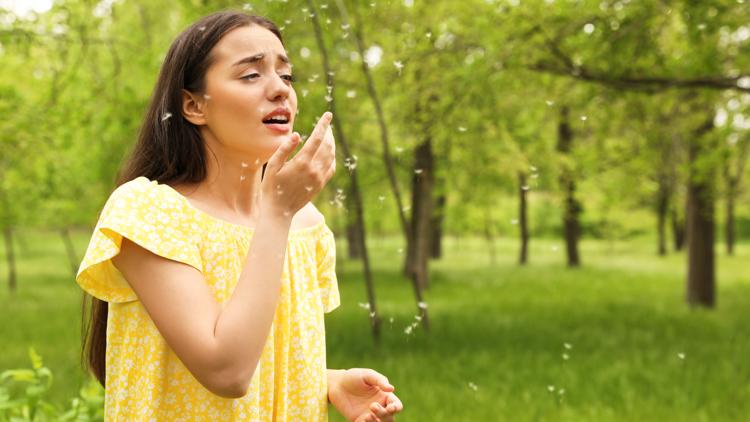Spring means flowers blooming, trees blossoming and seedlings sprouting in most of the United States, which leads to pollen being released into the air.
Pollen is a fine to coarse, powdery substance that is created by certain plants as part of their reproduction process, according to the National Institute of Environmental Health Sciences.
Exposure to pollen in the air can cause a variety of irritating symptoms in people who are exposed to it, or none at all, the Centers for Disease Control and Prevention (CDC) says. For people with seasonal allergies, also known as allergic rhinitis or hay fever, pollen exposure can cause sneezing, congestion and a runny nose.
Pollen in the air can also result in allergic conjunctivitis in some people, which causes red, watery, or itchy eyes, the CDC says. It can also cause asthma attacks in people who have asthma who are triggered by pollen.
We’re VERIFYING three common misconceptions about pollen and seasonal allergies.
THE SOURCES
- Centers for Disease Control and Prevention (CDC)
- National Institute of Environmental Health Sciences
- Asthma and Allergy Foundation of America (AAFA)
- Allergy & ENT Associates, the largest multi-specialty allergy, asthma and ENT group practices in the Houston, Texas, area
- Allergy & Asthma Network, a nonprofit outreach, education, advocacy and research organization for individuals and families living with allergies, asthma and related conditions
- Arkansas Allergy And Asthma Clinic
- Cleveland Clinic
- Family Allergy & Asthma, a group of board-certified allergy and asthma specialists with offices in Arkansas, Florida, Illinois, Indiana, Kentucky, Missouri, Ohio, Pennsylvania, and Tennessee
- Flonase, an allergy relief medicine brand
- Henry Ford Health
- OSF Healthcare
- Summit Health
- Rana Misiak, M.D., an allergist at Henry Ford Health
WHAT WE FOUND
1. It’s a myth that pollen from flowers is the leading cause of seasonal allergies.
Flowering plants that spread their pollen by insects like roses and daffodils usually do not cause seasonal allergies, according to the Asthma and Allergy Foundation of America (AAFA). Instead, our sources agree that most of the pollen that causes allergic reactions comes from trees, grasses and weeds.
“It’s a common misconception that flowers are one of the main causes of seasonal allergies,” Family Allergy & Asthma says on its website. “While flowers do contain pollen, it’s not as easily spread by the wind.”
Family Allergy & Asthma and Flonase, an allergy relief medicine brand, both say that flower pollen is heavier and stickier than the smaller, lighter, airborne pollen from trees, weeds and grasses.
“The pollen from showy, colorful flowers, such as roses, daffodils and sunflowers is heavy and sticky so it can be picked up and carried by insects and animals,” Flonase says. “As a result, the pollen from these flowers doesn’t get carried on the wind to cause your airborne allergy symptoms.”
If you’re allergic to pollen or suffer from seasonal allergies, the CDC recommends following the tips:
- Check pollen forecasts on local news and online, and plan to spend less time outdoors when pollen levels are high.
- Take your allergy and/or asthma medications as prescribed by your healthcare provider.
- Don’t touch your eyes while you’re outside, and wash your hands when you go back inside.
- Shower after being outside to remove pollen from your skin and hair.
- Change your clothes after being outdoors.
- Keep windows closed during pollen season.
- Use high-efficiency filters in your home’s HVAC system. Make sure your HVAC system can use high-efficiency filters and that they don’t violate the system’s warranty.
2. It’s a myth that seasonal allergies can only develop during childhood.
It’s possible for adults who did not experience seasonal allergies during their childhood to develop them later in life.
“Most people typically develop allergy symptoms at a young age, outgrow their allergies, and become tolerant around their 20s or 30s. But it’s possible to develop an allergy or become allergic to something at any point in your lifetime,” Allergy & ENT Associates says on its website.
Rana Misiak, M.D., an allergist at Henry Ford Health, agrees.
“Seasonal allergies can start and stop at any time during your life,” says Misiak.
Allergy & ENT Associates says it’s currently unclear how or why seasonal allergies develop in adulthood. However, researchers believe that having one severe allergic reaction or symptoms during childhood can increase your chances of developing allergies as an adult.
“The good news is that there are a variety of effective strategies and treatments to relieve allergy symptoms, allowing you to enjoy your daily activities,” says Misiak.
VERIFY found that it’s beneficial to start taking allergy medicine before symptoms start. We also found that nasal sprays are more effective at treating sinus symptoms than other types of allergy medicines. Click here for more VERIFIED remedies to treat seasonal allergies.
3. It’s a myth that you can escape seasonal allergies by moving to a drier climate.
Contrary to popular belief, moving to a drier climate, like a desert in the Southwestern U.S., will not cure your seasonal allergies. This is because pollen exposure can occur anywhere and everywhere, according to our sources.
“There really is no allergy-free zone. Pollen allergies can occur anywhere. Deserts have plenty of plants that produce pollen, such as sagebrush, cottonwood and olive trees. When pollen counts are high, you may experience symptoms,” the Allergy & Asthma Network, an allergy and asthma research nonprofit, says on its website.
Flonase and the Allergy & Asthma Network both note that relocating to a drier climate may only offer temporary relief from seasonal allergies triggered by pollen because allergies to local plants could eventually develop within a few years.
“The timing of your seasonal allergies and your allergic symptoms may vary in a different climate, but they may not vanish altogether,” the Allergy & Asthma Network says.
Summit Health and the Allergy & Asthma Network recommend talking to a healthcare professional about treatment options before you consider moving to help manage your pollen allergies.
This story is also available in Spanish / Lee este artículo también en español: Verificamos 3 datos breves sobre el polen y las alergias estacionales



